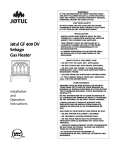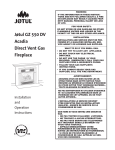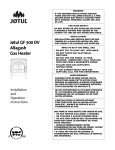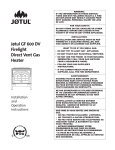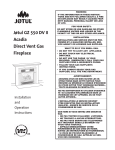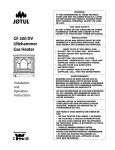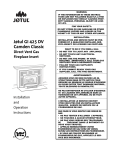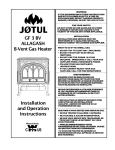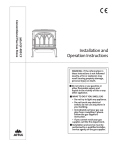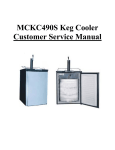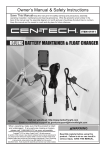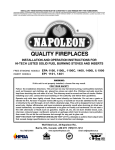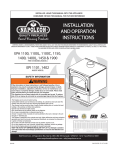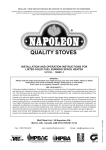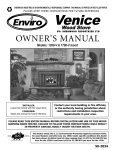Download Jotul GF300 BV User's Manual
Transcript
WARNING: IF THE INFORMATION IN THESE INSTRUCTIONS ARE NOT FOLLOWED EXACTLY, A FIRE OR EXPLOSION MAY RESULT CAUSING PROPERTY DAMAGE, PERSONAL INJURY OR LOSS OF LIFE. FOR YOUR SAFETY: DO NOT STORE OR USE GASOLINE OR OTHER FLAMMABLE VAPORS AND LIQUIDS IN THE VICINITY OF THIS OR ANY OTHER APPLIANCE. GF 300 BV Allagash Gas Stove INSTALLATION: INSTALLATION AND SERVICE MUST BE PERFORMED BY A QUALIFIED INSTALLER, SERVICE AGENCY OR LICENSED GAS SUPPLIER. THIS PRODUCT MUST BE INSTALLED BY A LICENSED PLUMBER OR GAS-FITTER WHEN INSTALLED IN THE COMMONWEALTH OF MASSACHUSETTS. A CARBON MONOXIDE (CO) DETECTOR SHALL BE INSTALLED IN THE SAME ROOM AS THE APPLIANCE. WHAT TO DO IF YOU SMELL GAS: • DO NOT TRY TO LIGHT ANY APPLIANCE. • DO NOT TOUCH ANY ELECTRICAL SWITCHES. • DO NOT USE THE PHONE IN YOUR BUILDING. IMMEDIATELY CALL YOUR GAS SUPPLIER FROM A NEIGHBOR’S PHONE. Installation and Operation Instructions • FOLLOW YOUR GAS SUPPLIER’S INSTRUCTIONS. • IF YOU CANNOT REACH YOUR GAS SUPPLIER, CALL THE FIRE DEPARTMENT. AVERTISSEMENT: ASSUREZ-VOUS DE BIEN SUIVRE LES INSTRUCTIONS DANS CETTE NOTICE POUR REDUIRE AU MINIMUM LE RISQUE D’INCENDIE OU POUR EVITER TOUT DOMMAGE MATERIEL, TOUTE BLESSURE OU MORTALIT’E. NE PAS ENTREPOSER NI UTILISER D’ESSENCE NI OU LIQUIDES INFLAMMABLES DANS LE VOISINAGE DE CET APPAREIL OU DE TOUT AUTRE APPAREIL. L’INSTALLATION LE SERVICE DOIVENT ETRE EXECUTES PAR UN INSTALLATEUR QUALIFIE, AGENCE DE SERVICE OU LE FOURNISSEUR DE GAZ. QUE FAIRE SI VOUS SENTEZ UNE ODEUR DE GAZ. • NE PAS TENTER D’ALLUMER L’APPAREIL • NE TOUCHEZ A AUCUM NTERRUPTEUR. • NE PAS VOUS SERVIR DES TELEPHONES SE TROUVANT DANS LE BATIMENT OU VOUS VOUS TROUVEZ. • APPELEZ IMMEDIATEMENT VOTRE FOURNISSEUR DE GAZ CHEZ UN VOISIN. SUIVEZ LES INSTRUCTIONS DU FOURNISSEUR. • SI VOUS NE POUVEZ REJOINDRE LE FOURNISSEUR DE GAZ, APPELEZ LE SERVICE DES INCENDIES. 1 Welcome to Jøtul... Congratulations on the purchase of your new Jøtul GF 300 BV Allagash gas stove. We at Jøtul are glad you’ve made the decision to warm your hearth with a Jøtul product. Your new stove exemplifies our experience gained over 150 years as the world’s largest manufacturer of solid fuel burning appliances. We’ve been making fine quality cast iron stoves and fireplaces continuously since 1853. The Jøtul GF 300 BV Allagash combines advanced gas technology with the warm, traditional elements of cast iron. With proper care and use, your stove will provide you with many years of safe, dependable and satisfying service. Please take a few minutes to familiarize yourself with this manual and the features of your new Jøtul fireplace. 2 Table of Contents Service Tools .............................................. 4 Specifications ........................................... 4 General Information ............................... 5 Safety Information .................................. 6 Installation Requirements Location ................................................. 6 Hearth Protection .............................. 6 Clearances ............................................ 7 Mantel & Trim ..................................... 7 Alcove ..................................................... 7 Vent Requirements ............................... 10 Fuel Conversion ...................................... 11 Gas Connection ...................................... 13 Gas Pressure ............................................ 14 Log Set Installation ............................... 15 Flame Adjustment................................. 16 Wall Thermostat .................................... 16 Remote Control ...................................... 16 Decorative Pipe ...................................... 17 System Check .......................................... 17 Operation ................................................. 18 Maintenance ........................................... 19 Glass Replacement ............................ 19 Optional Blower ..................................... 20 Optional Antique Brick Kit .................. 22 High Altitude Adjustment .................. 23 Illustrated Parts Breakdown ............... 24 Replacement Parts List ......................... 25 Lighting Instructions ............ Back Cover Jøtul GF 300 BV Allagash Gas Heater Manufactured and Distributed by: Jøtul A.S.A. Fredrikstad, Norway Jøtul North America Gorham, Maine U.S.A. M.E.A. 369-04-E Test Standards This appliance complies with National Safety standards and is tested and listed by Intertek Testing Services of Middleton, Wisconsin to ANSI Z21.88-2002 • CSA 2.33-M02 and CAN/ CGA 2.17--M91, CSA P.4.-01.2 for Canada. DO NOT ATTEMPT TO ALTER OR MODIFY THE CONSTRUCTION OF THE APPLIANCE OR ITS COMPONENTS. ANY MODIFICATION OR ALTERATION WILL VOID THE WARRANTY, CERTIFICATION AND LISTING OF THIS APPLIANCE. THIS OWNER’S MANUAL PROVIDES INFORMATION TO ENSURE SAFE INSTALLATION AND EFFICIENT, DEPENDABLE OPERATION OF YOUR FIREPLACE INSERT. PLEASE READ THESE INSTRUCTIONS IN THEIR ENTIRETY AND MAKE THEM AVAILABLE TO ANYONE USING OR SERVICING THIS GAS INSERT. THIS PRODUCT MUST BE INSTALLED BY A LICENSED PLUMBER OR GAS-FITTER WHEN INSTALLED IN THE COMMONWEALTH OF MASSACHUSETTS. 3 GF 300 BV Allagash Specifications The Jøtul GF300 BV Allagash is a atmosphericallyvented gas fireplace heater designed only for vertical venting directly to the outside of the house, using listed, Type B-vent pipe. Input Rates Natural Gas THIS FIREPLACE IS SHIPPED FROM THE FACTORY FOR USE WITH NATURAL GAS ONLY. FOR USE WITH PROPANE, THE APPLIANCE MUST FIRST BE CONVERTED USING #155592 FUEL CONVERSION KIT PROVIDED. CONVERSION SHOULD BE MADE BEFORE THE APPLIANCE IS INSTALLED. SEE PG. 11. 26,000 BTU/hr. maximum input 15,000 BTU/hr. minimum input Propane Suggested Tools for Installation and Service 26,000 BTU/hr. maximum input 13,500 BTU/hr. minimum input Inlet Pressure: Natural Gas: Propane: MIN MAX 5.0 WC (1.24 kPa) 7.0 WC (1.74 kPa) 12.0 WC (2.99 kPa) 14.9 WC (3.71 kPa) Manifold Pressure: Natural Gas: Propane: MIN 1.2 WC (.30 kPa) 2.9 WC (.722 kPa) MAX 3.8 WC (.95 kPa) 11.0 WC (2.74 kPa) Piezo Ignitor / Standing Pilot CL 11 1/2” 292 mm 4 1/2” 114 mm CL 16 1/2” 420 mm • • • • • • • • • • • • • • • • • • • External regulator (for Propane only) Piping which complies with local code Manual shutoff valve (T-Handle in Massachusetts) Sediment trap - if required by code Tee joint Pipe wrench Pipe sealant 10 mm open end wrench 1/2”, 7/16” open end wrench or deep socket Phillips head screwdriver Flat head screwdriver 1/4” nut driver 4 mm allen wrench Gloves Safety glasses Torx T20 screwdriver Leak test solution Reciprocating Saw Power Drill 23” 584 mm With Short Legs, reduce height by 2 1/4” ( 51 mm) CL 27 3/4” 705 mm Rear Exit 21 5/8 ” 550 mm 22 1/4” 565 mm 4 13” 330 mm Top ExitFlue Collar 25” 635 mm Top Plate 27 3/4” 705 mm General Information THIS HEATER MUST BE INSTALLED AND MAINTAINED BY A QUALIFIED SERVICE AGENCY. The installation and repair of this appliance must be done by a qualified service person. Failure to properly install and maintain this heater could result in an unsafe or hazardous installation, which may result in a fire, explosion, property damage, personal injury or loss of life. This appliance may be installed in an aftermarket permanently located, manufactured (mobile) home, where not prohibited by local codes. This appliance is only for use with the type(s) of gas indicated on the rating plate. This appliance is not convertible for use with other gases, unless a certified kit is used. Cet appareil peut être installé dans un maison préfabriquée (mobile) déjà installée à demeure si les règlements locaux le permettent. Cet appareil doit être utilisé uniquement avec les types de gas indiqués sur la plaque signalétique. Ne pas l’utiliser ave d’autres gas sauf si un kitde conversion certifié est installé. This appliance should be inspected before use and at least annually. More frequent cleaning may be required due to excessive lint from carpeting, bedding material, etc. It is imperative that control compartments, burners, and circulating air passageways of the appliance be kept clean. THIS APPLIANCE MUST NOT BE CONNECTED TO A CHIMNEY OR FLUE SERVING ANY OTHER APPLIANCE. Consult the local or national installation code(s) to assure that adequate combustion and ventilation air is available. Installer l’appareil selon les codes ou reglements locaux, ou, en l’absence de tels reglements, selon les Codes d’installation CAN/CGA-B149. DO NOT OPERATE THIS STOVE IF ANY PART HAS BEEN UNDER WATER. Call a qualified service technician to inspect the heater and to replace any part of the control system and any gas control which may have been under water. Ne pas se servir de cet appareil s’il a ete’ plonge dans l’eau, completement ou en partie. Appeler un technicien qualifie pour inspecter l’appareil et remplacer toute partie du syste’me de controle et toute commande qui ont ete plonges dans l’eau. Glass Panel Do not operate this appliance with the glass front removed, cracked, or broken. Replacement of the glass should be done by a licensed or qualified service person. Only remove glass for routine service. Always handle glass carefully. Unpacking your stove 1. Remove the Top Plate of the stove by simply lifting it straight off of the stove body. 2. To open the firebox, disengage the two Glass Frame Latches located on top of the firebox. Pull each handle forward to clear the latch from the notch in the frame. The installation must conform to local codes. Your local Jøtul dealer can assist you in determining what is required in your area for a safe and legal installation. Some areas require a permit to install a gas burning appliance. Always consult your local building inspector, or authority having jurisdiction, to determine what regulations apply in your area. Glass Frame Latch CODE COMPLIANCE: Your local officials have final authority in determining if a proposed installation is acceptable. Any requirement that is requested by the local authority having jurisdiction, that is not specifically addressed in this manual, defaults to local code. In the absence of local codes, the installation requirements must comply with the current edition of National codes. In the U.S., these requirements are established in the National Fuel Code, ANSI Z223.1.(NFPA 54) current edition. In Canada, the codes have been established in CAN/CGA B149 Fuel Installation Code, current edition. 3. Familiarize yourself with the installation requirements specified in this manual, before beginning the installation. Hardware Bag Contents • Fuel Conversion Kit - LP ................................ 155592 * Decorative Pipe Brackets ............................. 129469 5 Safety Information Location During normal operation, the GF 300 BV gas stove will reach high surface temperatures. Therefore: In selecting a location for the stove, consider the following points: 1) Heat distribution 2) Vent termination requirements 3) Gas supply line routing 4) Traffic areas, furniture, draperies, etc. Due to the high operating temperatures, this appliance should be located out of traffic areas and away from furniture and draperies. Children and adults should be alerted to the hazards of high surface temperatures and should stay away to avoid burns and/or clothing ignition. Young children should be supervised while they are in the same room as the GF 300 BV gas stove. Clothing or other flammable materials should not be placed ON or NEAR the GF 300 BV gas stove. Surveiller les enfants. Garder les vetements, les meubles, l’essence ou autres liquides a vapeur inflammables loin de l’appareil. NEVER store or use gasoline or any other flammable vapors or liquids in the vicinity of the GF 300 BV gas stove. Never burn any other materials in your GF 300 BV Allagash gas stove, it is strictly designed for use with natural gas or propane fuel ONLY. · Any safety screen, glass or guard removed for servicing the appliance must be replaced prior to operating the appliance. The GF 300 BV may be located on or near conventional construction materials, however, proper clearance to combustibles must be maintained in order to provide adequate air circulation around the appliance. Also, it is important to provide adequate access around the stove for servicing and proper operation. The clearance and hearth specifications listed in this manual are the minimum requirements for combustible material. A combustible material is anything that can burn (i.e. sheet rock, wall paper, wood, fabrics etc.). These surfaces are not limited to those that are visible and also include materials that may be located behind noncombustibles. If you are not sure of the combustible nature of a material, consult your local fire officials. “Fire Resistant” materials are considered combustible: they are difficult to ignite, but will burn. Also, “fire-rated” sheet rock is considered combustible. Hearth Requirements The GF 300 BV gas stove CANNOT be installed directly on carpeting, vinyl, linoleum or Pergo®. If this appliance will be installed on any combustible material OTHER THAN WOOD, a floor pad must be installed that is either metal or wood, or a listed hearth pad. This floor protection must extend the full width and depth of the appliance. It is not necessary to remove carpeting, vinyl or linoleum from underneath the floor protection. See fig. 1. Figure 1. Minimum Hearth Protection. 14” (356 mm) 24” (686 mm) 6 Stove and Vent Clearance Requirements Minimum Clearances from the Stove to Combustibles See figs. 2-3. Rear: Ceiling: Corner: Sides: 2” (51 mm) To Rear Wall 2” (51 mm) - measured from Draft Hood 32 1/4” (819 mm) - measured from stove top 3” (76 mm) - measured from stove top 3” (76 mm - measured from stove top) 3” (76 mm) 3” (76 mm) Minimum Clearances from the Vent Pipe to Combustibles Figure 2. Parallel Installation Clearances. Horizontal Run: Top: Off the top of the pipe 2” (50 mm) Sides: Off the sides and bottom 2” (50mm) 11 3/4 (298 mm) Vertical Run: All sides: 1” (25 mm) 3 (76 mm) 34 (864 mm) EA H RT Minimum Alcove Dimensions 3 (76 mm) Maintain clearances to combustibles as noted above. Width: Depth: Height: 36” (914 mm) 24” (610 mm) 61” (1550 mm) Mantel Clearances - 11 3/4 (298 mm) H All vent components must be installed in accordance with the manufacturer’s instructions and within the terms of their listing. Refer to the manufacturer’s instructions for approved clearances from the vent pipe to combustible materials. Figure 3. Vent adaptor centerline at minimum clearance to corner walls. Stove shown with standard legs. With Short Legs, subtract 2 1/4” (51 mm) from the clearances indicated below. Max. Mantel Depth 11.5 9.5 7.5 5.5 3.5 Mantel Depths as in Fig.4. Min. Mantel Depth Max. Top Trim Depth = 1 Mantel Sheild: Min. 24 ga. steel 26 wide on 1 spacers No Top Trim 1 11 (266 mm) 44 1/4 1124 mm 56 3/4 53 3/4 50 3/4 1441 mm 1365 mm 1289 mm 55 1/4 1403 mm 52 1/4 1327 mm 41 1/4 1047 mm 42 3/4 1086 mm 38 1/4 972 mm 39 3/4 1010 mm 27 3/4 705 mm 27 3/4 705 mm Max. 6 1/2 165 mm Figure 4. Mantel and Trim specifications Stove installed flush with fireplace face. Figure 4a. Mantel specifications Stove recessed into fireplace no more than 6 1/2”. 7 Vent Requirements The GF 300 BV Allagash is specifically designed to operate using 4” Type B vent pipe components or a Listed Flexible gas liner. • All venting components must be installed in accordance with the terms of their listing and manufacturer’s instructions. • The minimum height of a vertically terminated system shall be no less than 7', and the maximum height shall be no more than 35'. See diagrams page 9. • With steep roofs, nearby trees, and in predominant windy conditions, poor draft or down draft conditions can occur. In these cases, increasing the height of the vent or high wind termination caps may improve the situation. • ELBOWS: If an offset or elbow is necessary in the vertical rise, it is important to support the vent pipe every three feet, to avoid excessive stress on the offsets. • Whenever possible use 45° elbows opposed to 90° elbows. This offers less restrictions for the flow of flue gases. Figure 5. Termination Height Requirements. Maximum number of 90° elbows: three Maximum number of 45° elbows: four • TOTAL MAXIMUM HORIZONTAL RUN ANYWHERE IN THE VENTING CONFIGURATION IS 4 FEET. The distance between any 45° elbows is considered a horizontal run. See diagrams, page 10. • Any Type B vent passing through a roof must have a flashing, storm collar, thimble and a Type B cap is required. See diagrams, page 10. • Venting on the Allagash CANNOT be less than 4” in diameter or greater than 4” in diameter. • Any unused flue or masonry enclosure can be used as a passage way for venting, but the flue must be relined using Type B 4” vent or Listed Flexible Gas Liner. • The remaining space around the liner in a masonry or zero-clearance flue CANNOT be used to vent any other appliance. 8 • When terminating through the roof refer to the Gas Vent Rule for proper vent termination height. See fig. 5. • NO venting may terminate horizontally or below roof eaves. • Passage through combustibles (walls, ceilings) must be with Type B venting and must maintain listed clearances. • Any horizontal run should have an upward slope of 1/4” per foot toward the termination cap. • When venting through a thimble into a masonry flue, any venting exposed in the room must be Type B venting, or a flexible liner sleeve within 24 ga. 6” stove pipe. • Listed Flexible Gas Liners may not be exposed in any living space. • When 6” diameter decorative pipe is installed to cover the venting any Listed Flexible Gas liner must be connected directly to the stove’s draft hood. • Use of single wall connector pipe as a vent is prohibited for use with the GF300 Allagash B-Vent stove. Venting through a Masonry or Prefabricated Manufactured Chimney Storm collar required Top sealing achor plate Listed termination cap required • A firestop is required at every floor. • Any venting that is exposed above the first floor, regardless of attic space or living space, must be enclosed. Always maintain the required clearance from all sides of the vertical vent system according to manufacture. • Installation of any components not manufactured or approved by Jøtul or failure to meet all clearance requirements will void all warranties and could result in property damage, bodily injury, or serious fire. • Never modify any venting component, or use any damaged venting product. Type B vent or Listed Flexible Gas Liner. Use of Type B vent liner within outside chimneys is recommended to help keep the gases warm and stabilize draft. Max. Height 35 ft. Min. Height 7 ft. • THE GAS APPLIANCE AND VENT SYSTEM MUST BE VENTED DIRECTLY TO THE OUTSIDE OF THE BUILDING, AND NEVER ATTACHED TO A CHIMNEY SERVING A SOLID FUEL OR GAS BURNING APPLIANCES. • BE SURE TO MAINTAIN THE PROPER CLEARANCES TO COMBUSTIBLES AS DEFINED IN THIS MANUAL AND IN THE INSTRUCTIONS PROVIDED WITH EACH VENTING COMPONENT. • When installing at an altitude above 2000’ the minimum vertical rise becomes 12’ from the draft hood. NOTE: Always maintain the proper clearance to mantel and trim Maximum offset is 4 ft. Recommended damper sealing plate to seal flue chamber to prevent heat loss A chimney system located outside the building envelope may be subject to downdrafting and/or flow reversal. Atmospherically-vented appliances, such as B-Vents, may not be compatible with these chimney systems. All atmospherically-vented appliances (B-Vents) are affected by atmospheric conditions and house pressurization. For example, a B-Vent appliance vented to an outside chimney system in a basement will likely be subject to negative pressure. This type of installation is not recommended. WARNING: FAILURE TO POSITION THE PARTS IN ACCORDANCE WITH THIS DIAGRAM OR FAILURE TO USE ONLY PARTS SPECIFICALLY APPROVED WITH THIS APPLIANCE MAY RESULT IN PROPERTY DAMAGE OR PERSONAL INJURY. Figure 6. GF 300 BV venting through a masonry chimney. 9 Approved B-Vent Configurations Listed B-Vent Termination Cap required. Maximum chimney height off Draft Hood is 35 feet. NOTE: Installation at altitude greater than 2000’ requires minimum 12 ft. vertical rise from Draft Hood. Minimum chimney height off Draft Hood is 7 feet. Figure 7. 10 Maximum total horizontal anywhere in venting configuration is 4 feet. Minimum chimney height from Draft Hood is 7 feet. Max. Four, 45° or Three, 90° Elbows Minimum chimney height from Draft Hood is 7 feet. NOTE: Installation at altitude greater than 2000’ requires minimum 12 ft. vertical rise from Draft Hood. Listed B-Vent termination cap required. Maximum total horizontal offset anywhere in venting configuration is 4 feet. Minimum chimney height from Draft Hood is 7 feet. Max. Four, 45° or Three, 90° Elbows Maximum horizontal offset anywhere in venting configuration is 4 feet. Figure 9. Listed B-Vent Termination Cap required. Figure 8. Listed B-Vent termination cap required. NOTE: Installation at altitude greater than 2000’ requires minimum 12 ft. vertical rise from Draft Hood. NOTE: Installation at altitude greater than 2000’ requires minimum 12 ft. vertical rise from Draft Hood. Figure 10. Conversion Kit Contents: Fuel Conversion The GF 300 BV gas stove is shipped from the factory equipped to burn NATURAL GAS only. If PROPANE gas is to be used as fuel, the appliance must first be converted for use with propane. Use Propane Conversion Kit 155592, supplied with the appliance. Order and install NG Conversion Kit 155593 to change back to use with natural gas. WARNING: THE CONVERSION KIT IS TO BE INSTALLED BY AN AUTHORIZED JØTUL SERVICE TECHNICIAN IN ACCORDANCE WITH THE MANUFACTURER’S INSTRUCTION AND ALL CODES AND REQUIREMENTS OF THE AUTHORITY HAVING JURISDICTION. FAILURE TO FOLLOW THESE INSTRUCTIONS COULD RESULT IN SERIOUS INJURY OR PROPERTY DAMAGE. THE QUALIFIED AGENCY PERFORMING THIS WORK ASSUMES RESPONSIBILITY FOR THIS CONVERSION. IN CANADA: THE CONVERSION SHALL BE CARRIED OUT IN ACCORDANCE WITH THE REQUIREMENTS OF THE PROVINCIAL AUTHORITIES HAVING JURISDICTION AND IN ACCORDANCE WITH THE REQUIREMENTS OF THE CAN1-B149.1 AND .2 INSTALLATION CODE. AVERTISEMENT: Cet equipement de conversion sera installe par une agence qualkfiee de service conformenment aux instructions du fabricant et toutes exigences et codes applecables de l’autorises avoir la juridiction. Si l’informaiton dans cette Instruction n’est pas suivie exactement, un feu, explosion ou production de protoxyde de carbone peut resulter le dommages causer de propriete, perte ou blessure personnelle de vie. L’agence qualifiee’ de service est esponsable de l’installation propre de cet equipement. L’installation n’est pas propre et complete jusqu’a l’operation de l’appareil converti est cheque suivant les criteres etablis dans les instructions de proprietaire provisionnees avec l’equipement. • 1, regulator tower labeled for propane • 3, regulator tower screws • 1, burner orifice (#39 for NG, #53 for LPG) • 1, pilot orifice (#51 for NG, #30 for LPG) • Label A - to be completed and applied to the back of the stove • Label B - apply to the stove’s Rating Plate • Small valve label - apply to valve body Conversion instructions are also shipped in the stove with the conversion kit. Fuel Conversion Procedure 1. Turn off gas supply to stove. 2. Remove the stove Top Plate. 3. Disengage the two Glass Frame Latches at the top of the firebox. See illustration on page 5. Carefully lift the glass panel up and out of the stove. 4. If installed, remove the Embers and Log Set using care not to damage the fragile log parts. 5. Lift out the Burner Skirt shown in fig.11. 6. Reach under the stove and remove the Air Shutter wingnut from its stud. As you face the right side, it is the one closest to you. See fig. 12. Burner Skirt Figure 11. Lift and remove the Burner Skirt from within the firebox. Open Close Tools required: • 1/2” open ended wrench or deep-well socket, Torx T20 or slotted screwdriver, 4 mm allen wrench. Figure 12. Locate and remove the Air Shutter wingnut from under the right side of the stove. 11 7. Lift out the Burner Plate: NOTE: There are no screws securing the Burner to the floor of the firebox. Pull the Air Shutter forward and lift the burner together with shutter up and out of the stove as a unit. See fig. 13. 8. 9. Change the Burner Orifice. See fig. 14. Using a ½” open ended wrench or deep-well socket remove the burner orifice from its brass elbow housing and replace with the appropriate orifice supplied in the kit. Replace the Air Shutter with its gasket and push it all the way back to allow replacement of the Burner Plate. Reattach the wingnut to the shutter stem under the stove, but do not tighten. You will set its final position later. 10. Replace the Burner Plate. Engage the burner tube with the Air Shutter assembly as in fig. 13. Be sure the burner is securely engaged with the two support brackets at the front of the firebox and push the plate back toward the rear of the firebox. When correctly positioned, there will be 1/2” (13 mm) clearance between the burner plate and the front of the firebox. See fig. 15. Air Shutter Burner Plate Figure 13. Remove the Air Shutter and Burner as a unit. Burner Orifice 11 . CHANGE THE PILOT ORIFICE: From within the firebox, remove the Pilot Head by pulling it straight up from the pilot base. See fig. 16. Using the 4 mm hex key included with the kit, unscrew the pilot orifice (counterclockwise). Replace with the appropriate orifice: 12. Tighten orifice into the base of the pilot assembly. To prevent bypass leaks, be sure the orifice is secured tightly and flush with the base. Replace pilot head by pushing it down onto the pilot base. Figure 14. Change the Burner Orifice. 13. Replace the Variable Regulator. Using a Torx T-20 screwdriver, remove the three screws from the front of the valve regulator. See fig. 17. 14. Remove the Regulator Tower, Gasket, white plastic disk, and Spring. Remove the black rubber gasket from the valve. See fig. 17. 1/2” Figure 15. Correct Burner Position - maintain 1/2 inch clearance between burner and firebox front. 12 Regulator Tower Pilot Head Remove black gasket from regulator assembly Orifice Retainer Clip Valve Pilot Base Figure 16. Pilot orifice removal and replacement. 15. Install the new regulator: Be sure the new gasket is properly positioned and tighten screws securely. 16. Install the identification labels to the stove so that they can be seen by any person that may be servicing the stove. Label A: apply to back of stove. Label B: apply to stove’s rating plate. Small valve Label: apply to valve. 17. Reassemble the stove, apply gas to the system and check for leaks using a soapy water solution. NEVER USE AN OPEN FLAME TO CHECK FOR GAS LEAKS. 18. Correct gas pressure is essential for efficient and safe operation of this appliance. Use a manometer to check pressures as specified in the Gas Pressure section of this manual (page 15). 19. Adjust the Air Shutter. You will need to position the shutter to provide a gas/air mixture that will achieve the best flame picture with your particular installation. Start with the shutter stem at the half-way position in the slot in the bottom of the stove. See fig. 12. Pushing the stem back will restrict air, while pushing it forward will open the shutter and increase air. With some experimentation, you will find the shutter position that works best for your installation. ALWAYS REFER TO THE LIGHTING INSTRUCTIONS ON THE INSIDE BACK COVER OF THIS MANUAL WHEN LIGHTING YOUR STOVE. Figure 17 Regulator assembly. Gas Supply Connection BLOWER NOTE: Install the optional blower before connecting the gas line in order to ensure adequate clearance between both. The gas supply line connection is made to the left side of the front-mounted valve. The gas supply line should be 3/8" npt with a 1/2" diameter supply, or the appropriate size to provide sufficient gas pressure to the valve regardless of the input setting. The use of Flexible Gas Appliance Connectors is acceptable in many areas in the U.S. However, Canadian methods vary depending on local code. ALL INSTALLATIONS MUST COMPLY WITH LOCAL CODE OR IN THE ABSENCE OF LOCAL CODE, MUST COMPLY WITH THE MOST RECENT EDITION OF THE NATIONAL FUEL GAS CODE ANSI Z223.1/NFPA 54 OR CAN-B149. All codes require a gas shut-off valve (gas cock) and union, to be installed in the supply line, and in the same room as the appliance. This allows for the disconnection of the stove for servicing and maintenance. See fig. 18. A T-HANDLE GAS COCK IS REQUIRED IN MASSACHUSETTS TO COMPLY WITH CODE 248CMR. Secure all joints tightly using appropriate tools and sealing compounds. For propane units be sure to use compounds that are propane resistant. Turn on gas supply and test for gas leaks using a soapy water solution. Never use an open flame to check for leaks. 13 E A Figure 19. Pressure test points. INLET GAS PRESSURES (inches water column) Figure 18. Supply valve connection fittings. Leak test: 1. Mix a 50-50 solution of water and dish soap. 2. Light appliance- see lighting instructions on the inside back cover of this manual or on the stove’s rating plate. 3. Brush or spray all joints and connections with the soapy water solution. 4. If bubbles appear at any connection or seam or a gas odor is detected, immediately turn gas control knob to the OFF position. 5. Tighten or reconnect the leaking joint and retest for any gas leaks. Gas Pressure Correct gas pressure is essential for efficient and safe operation of the GF 300 BV gas stove. It is important that the correct pressure is established at the time of the installation. Proper gas pressure provides a consistent flow of gas to the appliance and is instrumental in checking for gas leaks. Pressure Test: Attach a manometer to the appropriate test point on the valve. See fig. 19. The gauge connections are located on the front of the valve under the On/Off/Pilot- knob. Gauge connections are identified by: E - for Inlet or Supply Pressure (the amount of gas coming to the valve.) A - for Manifold Pressure (the amount of gas that is coming out of the valve to the burner.) ALWAYS TEST PRESSURES WITH VALVE CONTROL KNOB SET ON HIGH. 14 NATURAL GAS PROPANE MIN MAX 5.0 12.0 7.0 14.9 The appliance and its appliance main gas valve must be disconnected from the gas supply piping system during any pressure testing on that system at test pressures in excess of 1/2 psig (3.5 kPa). The appliance must be isolated from the gas supply line by closing its individual manual gas shut-off valve (gas cock) during any pressure testing of the gas supply piping system that is equal to or less than pressures of 1/2 psig (3.5 kPa). MANIFOLD PRESSURES (inches water column) MIN MAX NATURAL GAS PROPANE 1.2 2.9 3.8 11.0 Log Set Installation Brick Kit Note: Install the optional Antique Brick Kit 155370 before installing the logset. See page 22 and the instructions provided with that kit. The GF 300 BV logset must be installed before operating the burner. The logset includes four log pieces, packaged inside the firebox, and a quantity of ember stones packaged in the Miscellaneous Parts bag. To install the log set, remove the packaging and place the parts inside the firebox as illustrated in figures 20-24. Do not handle the log set with your bare hands. Always wear gloves to prevent skin irritation from the ceramic fibers. Figure 21. Install Right Log The ember stones realistically simulate glowing coals when the burner is operating. These should be spread evenly over the burner plate and around the logs. DO NOT OBSTRUCT THE PILOT ASSEMBLY OPENING. Do not pile the embers in front ot the burner skirt edges. See fig. 24. NOTE: You do not need to use all of the ember stones. With experimentation, you will find the arrangement and quantity of embers that works best with your stove. Depending upon the characteristics of your installation, it is possible that too many ember stones can promote sooting on the logs. Adjust the quantity of ember stones as appropriate to maintain the best overall flame picture and burner performance. Figure 22. Install Left Log THE CERAMIC FIBER LOGS AND GLOWING EMBERS CAN IRRITATE YOUR SKIN. GENTLY WASH YOUR HANDS WITH WARM SOAPY WATER AFTER HANDLING THE LOGS. Figure 23. Install Middle Log Pilot Assembly 1/4 6 mm Figure 20. Engage the holes in the underside ot the Rear Log with the two pegs in the burner skirt. 1/4 6 mm Figure 24. Position embers loosely and maintain 1/4” clearance from the burner skirt edges. 15 Flame Appearance / Air Shutter Adjustment Optional Wall Thermostat or Remote Control The GF 300 BV gas stove is shipped from the factory equipped to burn Natural gas. If the stove has been converted for use with propane, the Air Shutter may require adjustment to achieve the desired flame appearance. Other installation related variables can also affect the flame picture. The Air Shutter may be opened or closed to provide the best flame picture for your specific installation. Use only a 750 millivolt DC two-wire circuit thermostat with this appliance. The thermostat should be placed in the same room as the heater, typically 5 feet off the floor. Avoid drafty areas or any area that may affect the accuracy of the thermostat. Too large an air opening - the appliance will generate a flame that is blue and transparent, or an “anemic” flame. Too small an air setting - the appliance will generate very long yellow flames resulting in soot. Sooting produces black deposits on the logs, on the inside walls of the appliance, and potentially on the exterior termination cap. Sooting is caused by incomplete combustion in the flames and lack of combustion air entering the air shutter opening. To adjust the air shutter: 1. Reach under the right side of the stove and loosen the wingnut located closest to you. See fig. 25. Slide the wingnut stud forward to open the air shutter and back to provide less air. Make adjustments in small increments. 2. Tighten the wingnut to secure the shutter at the desired setting. 3. Allow the stove to burn for 30 minutes on the HIGH setting, observing the flame continuously. If the flame appears weak, slow, or sooty, repeat the process described above until the flame is as desired. WARNING: AIR SHUTTER ADJUSTMENTS SHOULD ONLY BE PERFORMED BY A QUALIFIED PROFESSIONAL SERVICE TECHNICIAN. The thermostat should be connected to the GF 300 BV using a minimum of 16 gauge wire with a maximum length of 25 feet of wire. Connect the two thermostat wire leads to the two lower terminals on the terminal block located directly above the ignitor button. Do not overtighten the connections. IT IS NOT NECESSARY TO DISCONNECT ANY OTHER WIRES. See Fig. 26. For thermostatic operation, the On/Off/T-Stat switch on the back of the stove must be in the T-stat position, and the pilot light must be running, as it is the power source for the thermostat. At the thermostat, the two wires should be connected to the two connection screws on the thermostat base plate per the manufacturer’s instructions. Remote Control When using a remote, the remote receiver should be wired to the terminal block the same way the thermostat would be. See the instructions above. Follow the operating instructions included with the Remote Control unit. CAUTION: LABEL ALL WIRES PRIOR TO DISCONNECTION WHEN SERVICING THE CONTROLS. WIRING ERRORS CAN CAUSE IMPROPER OR DANGEROUS OPERATION. ALWAYS VERIFY PROPER OPERATION AFTER SERVICING THE APPLIANCE. THERMOPILE SPILL SWITCH Black Black ROCKER SWITCH Red White Open ON Purple TH Close OFF TP TSTAT TH TP VALVE Orange White Yellow TERMINAL BLOCK OPTIONAL THERMOSTAT or REMOTE CONTROL Figure 25. Loosen the wingnut to adjust the air shutter. Figure 26. Valve and Accessory wiring diagram. 16 Installing Decorative Pipe System Check The use of decorative pipe is optional. No decorative pipe is included with the Jøtul GF 300 BV Allagash, however, four locator brackets are included with the stove in the hardware bag. The brackets are used to center the decorative pipe over the draft hood on which the pipe rests. Follow the procedure below to attach the brackets to the stove. 1. PURGING THE GAS LINE: When lighting the appliance for the first time, it will take a few moments to clear the gas line of air. Once this purge is complete, the appliance will operate as described in the lighting instructions. See the inside back cover of this manual or the stove Rating Plate attached the bottom of the stove. Subsequent burner starts will not require purging the gas line unless the supply line is shut off. 1. Remove the four 1/4” hex head screws that attach the 4” Flue Collar to the draft hood, but do not remove the Flue Collar. See Figure 27. 2. Align the “L”- shaped pipe brackets with the holes on the Flue Collar and attach using the four 1/4” hex head screws, located in the Misc. Hardware Bag. Reminder: Do not use single wall stove pipe as the vent pipe on this appliance. 2. PILOT FLAME: You can monitor the pilot flame through the view port located at the rear of the Right Log. See fig. 28. The pilot flame should be steady - not lifting or floating. The flame should be blue in color around the pilot hood, with traces of yellow toward the outer edges. The pilot flame should engulf the top 3/8” of the thermopile (to generate millivolt current) and the top 1/8” of the thermocouple. The pilot flame should project out of the pilot hood 1” at all three ports. See fig. 28. 3. BURNER ADJUSTMENT: This stove is equipped with a variable gas control valve that allows easy adjustment of the flame height appearance and heat output. To adjust the flame between the HI and LOW setting, rotate the HI/LOW knob, located in the center of the valve face. Fire intensity can be adjusted up to 50% between the LOW and HIGH settings. See fig. 29. Spill Switch NO SMOKE OR SOOT SHOULD BE PRESENT. CHECK LOG PLACEMENT IF ANY SOOT OR SMOKE IS PRESENT. IF SOOT OR SMOKE PERSISTS, THE AIR SHUTTER MAY NEED TO BE ADJUSTED. See Air Shutter/Flame Appearance section of this manual for proper air shutter settings and adjustments. Note: the more offsets there are in the vent system, the greater the need for an air shutter adjustment. See page 16. 1 (25mm) Figure 27. Decorative pipe attachment. 1/8 (3mm) Min. 3/8 (8mm) Min. Figure 28. Proper pilot flame appearance. 17 WARNING: AIR SHUTTER ADJUSTMENTS SHOULD ONLY BE PERFORMED BY A QUALIFIED PROFESSIONAL SERVICE TECHNICIAN. If a vacuum is used during any service on the stove, ALWAYS be sure the stove is cold and there are NO hot embers. 5. Remember, this appliance has a continuous burning pilot flame. Exercise caution when using products having combustible vapors. Always shut-off gas supply while servicing the stove. 6. CAUTION: DO NOT OPERATE THIS APPLIANCE WITH THE GLASS REMOVED CRACKED OR BROKEN. Replacement of the glass should be done by a licensed or qualified service person. Use only replacement glass provided by your authorized Jøtul dealer. Never use any substitute materials. Figure 29. Flame appearance on the “high” setting after approximately 15 to 20 minutes burning. CAUTION: DO NOT ATTEMPT TO ALTER THE FLAME APPEARANCE BY POSITIONING THE GAS VALVE CONTROL IN ANY OTHER POSITION OTHER THAN THE FULL “ON” POSITION. Operation Familiarize yourself with the controls of the GF 300 BV. Make sure that anyone else using the appliance is also familiar with the controls and operation procedures. Always follow the Lighting Instructions on the inside back cover of this manual and also located on the Rating Plate attached to the burner assembly. 1. Once the pilot is lit, burner operation is controlled by the rocker switch located at the left corner of the rear shroud. See fig. 30. ON / OFF - use for manual control of the burner. T-STAT - use for optional thermostatic or remote control operation. The burner will be controlled by those accessories. 2. During the first few fires, you may notice odor and/or smoke from the stove. This is normal and results from burn-off of manufacturing residue and curing of materials. You may find it helpful to provide additional ventilation and fresh air to alleviate this condition. 3. Condensation may occur on the glass upon each lighting of the appliance. This “fog” will disappear as the appliance heats up. 4. Keep the controls and the area under the appliance free of debris, vacuum this area frequently. Always keep the appliance area clear and free from combustible materials, gasoline and other flammable liquids. 18 WARNING: OBSERVE CAUTION WITH THE GLASS. THE GLASS PANEL MAY SHATTER UNEXPECTEDLY IF STRUCK WITH AN OBJECT. ALWAYS HANDLE THE GLASS PANEL WITH CARE. WHEN SERVICING THE STOVE ALWAYS PULL THE GLASS ASSEMBLY STRAIGHT UP FOR REMOVAL. 7. Clean the glass only when necessary. Wipe surface with a clean, damp soft cloth. Follow with a dry, soft towel as desired. Take care not to scratch the glass surface. WARNING: DO NOT USE ABRASIVE CLEANERS ON THE GLASS. NEVER CLEAN THE GLASS WHEN IT IS HOT. BLOCKED FLUE SWITCH NOTE: This appliance is equipped with a Spill Switch which will disable the burner in the event that the vent system becomes blocked. Located on the side of the Draft Hood, at the back of the stove, the switch has a reset button that, when pressed, will re-enable burner function. See Fig. 27. If the Spill Switch repeatedly shuts the burner off, turn off the gas supply and call your dealer or service technician. The Spill Switch will continue to shut off the burner until the vent problem has been corrected. Not all vent problems can be corrected as B-Vent appliances are affected by atmospheric conditions and house pressurization. AUTO OFF TSTAT MAN OFF BLOWER ON BURNER Figure 30. Burner Switch and Optional Blower Controls Maintenance Your Jøtul GF 300 BV Allagash and its venting system should be inspected before use and at least annually by a qualified service technician. Use the form on page 26 to keep a maintenance history of your stove. FOR REPLACEMENT, USE ONLY JØTUL CERAMIC GLASS REPLACEMENT KIT 155599. DO NOT USE ANY OTHER TYPE OF GLASS WITH THIS APPLIANCE. Glass Panel or Gasket Removal 1. Lift the Top Plate off of the stove. IMPORTANT: ALWAYS TURN OFF THE GAS SUPPLY TO THE FIREPLACE AND UNPLUG THE FORCED AIR BLOWER BEFORE ANY SERVICE WORK IS PERFORMED ON THE FIREPLACE. Annual Cleaning Vent System The entire vent system, including the chimney, should be inspected and cleaned every year. If the intake and exhaust venting is disassembled for any reason, it should be reassembled and sealed according to the manufacturer’s instructions provided at the initial installation. 2. Release the two Glass Frame Latches. Pull each latch handle forward forward to disengage the latch from the notches in the glass frame. 3. Lift the glass frame all the way up and out of the top of the stove. Lay this assembly on a flat surface, protecting the frame from scratches using a blanket or towel. 3. The glass panel is held in place by four compression clips. Use a screwdriver or small pliers to pry these up off the edge of the glass retaining walls. See fig. 31. 4. Remove the old gasket material. See fig. 32. Burner and Logset Periodically inspect the Firebox, Valve Compartment, Convection Airways and optional Blower to BE CERTAIN THAT THE FLOW OF COMBUSTION AND VENTILATION AIR IS UNOBSTRUCTED. The firebox should be vacuumed annually to remove any surface build up. Use a soft brush attachment and handle the logs carefully as they are fragile. Be sure to vacuum or wipe off the pilot assembly and burner surfaces. Figure 31. Use small pliers to pry up the two retainer tabs. Glass Panel or Gasket Replacement Glass Care Clean the glass only when necessary. Wipe the surface with a clean, dampened, soft cloth. Follow with a dry, soft towel. Take care not to scratch the glass surface. WARNING: DO NOT USE ABRASIVE CLEANERS ON THE GLASS. NEVER CLEAN THE GLASS WHEN IT IS HOT. 1. Wrap the new gasketing material evenly around the edge of the glass, peeling back the protective strip to expose the adhesive as you go. Press the adhesive side down onto the glass surface. Do not stretch the gasket. 2. Place the gasketed glass within the frame and press each of the retainer clips back into place on the retainer walls. Gasket Inspection It is important that the glass gasket be inspected at least annually. Examine the ribbon gasket for signs of deterioration and make sure the gasket has a positive seal. Replace the gasket if necessary. Refer to the replacement parts list on page 25. Figure 32. Wrap the gasket around the glass panel. 19 Optional Blower # 155620 CONNECT THE GAS SUPPLY TO THE STOVE BEFORE INSTALLING THIS BLOWER. IF NECESSARY, USE A 90° ELBOW OFF THE GAS VALVE TO CREATE ADEQUATE GAS LINE CLEARANCE. BE SURE ALL WIRE CONNECTIONS HAVE BEEN MADE BEFORE CONNECTING TO POWER SUPPLY. 5 4 6 1 2 1. Unpack and check the contents of the blower kit. Contact your dealer if any damage is evident or parts are missing. See fig. 33. 3 2. Attach the Snapstat Bracket to the studs located underneath the stove in the middle of the firebox floor using the two M6 hex nuts and a 10 mm wrench. See fig. 34. 3. Attach the Blower to the stove with the screen opening to the rear using the two M6 flange head hex bolts as shown in fig. 35. 4. Attach either Snapstat wire connector to either Snapstat terminal. See fig. 35. 5. Install the Snapstat by sliding it all the way into the slot in the Snapstat Bracket as shown in fig. 34. 6. Connect the female Control Switch quick-connector to the male control switch wire harness already installed in the stove. See fig. 35. 7. Connect power cord to the nearest outlet. 7 Contents 1. Blower 2. Snapstat Wire Harness 3. Control Switch Wire Harness 4. Snapstat 5. Snapstat Bracket 6. M6 Flange Nuts, (2) 7. M6 x 12 Hex Bolts, (2) Tools Required • 10 mm wrench Figure 33. Blower Kit Components THIS BLOWER MUST BE ELECTRICALLY GROUNDED IN ACCORDANCE WITH LOCAL CODES OR, IN THE ABSENCE OF LOCAL CODES, WITH THE CURRENT ANSI/ NFPA 70, NATIONAL ELECTRICAL CODE OR CSA C22.1-CANADIAN ELECTRICAL CODE. THIS UNIT IS SUPPLIED WITH A THREE-PRONG (GROUNDING) PLUG FOR PROTECTION AGAINST SHOCK HAZARD AND SHOULD BE PLUGGED DIRECTLY INTO A PROPERLY GROUNDED THREEPRONG RECEPTACLE. DO NOT CUT OR REMOVE THE GROUNDING PRONG FROM THE PLUG. 20 ALWAYS DISCONECT THE POWER SUPPLY WHEN PERFORMING ANY SERVICE ON THE FIREPLACE INSERT. Snapstat Bracket Hex Head Flange Nuts Figure 34. Attach Snapstat Bracket. Figure 35. Attach Blower to the stove bottom and connect wires to Snapstat and female control quick connect. Male Quickconnector Snapstat Connectors Female Quickconnector M6 x 20 mm Hex Bolts Blower Operation The optional variable-speed blower will enhance heat circulation around the firebox and out into the room. The blower is controlled by a heat activated switch (snapstat) that will ONLY function when the control switch is in AUTO setting. After the fire has been burning for a time, the snapstat will react to the heat and activate the blower. Fan speed may be manually adjusted with the rheostat knob. If the burner turns off, the blower will be shut off automatically when the stove cools down. If automatic blower circulation is not desired, place the blower control switch in the MANUAL position. Manual or Automatic Modes Speed Control AUTO OFF TSTAT MAN OFF BLOWER GN W BK BK BK BK BK BR BR GY GY BL BL RHEOSTAT W BL BK BK SNAPSTAT QUICKCONNECTOR AUTO OFF MANUAL SWITCH Figure 37. Blower Wiring Diagram CAUTION: LABEL ALL WIRES PRIOR TO DISCONNECTION WHEN SERVICING CONTROLS. WIRING ERRORS CAN CAUSE IMPROPER AND DANGEROUS OPERATION. VERIFY OPERATION AFTER SERVICING. BLOWER ON BURNER Figure 36. Blower Controls ATTENTION: Au moment de l’entrentien des commandes, etiquietez tous le fils avant le debranchement. es erreurs de ceblage peuvent entra tun fonctionnement inadequat et dangereux. 21 Optional Antique Brick Kit # 155648 CAUTION! THE BRICK PANELS AND LOG PARTS ARE EXTREMELY FRAGILE. HANDLE WITH CARE. Read these instructions before beginning the installation. 1. Remove the Top Plate. Simply lift it up off of the stove body. It is not fastened. Figure 39. Disengage the compression latches to remove the glass frame. 2. Remove the Glass Frame. Disengage the two compression latches located at the top of the firebox and lift the glass frame up and off of the stove. See fig. 39. 3. If installed, remove the Logset. These parts are not fastened. Simply lift them out of the firebox. You do not have to remove the embers. 4. Install the Lower Rear Panel. Position it up against the back wall, resting on the burner skirt. Fig. 40. 5. Install a Side Panel. Tilt the panel, bottom edge first, into position against the side wall. The panel will stand on its own against the wall, fitting snugly between the rear panel and the front wall of the firebox. Fig. 41. Figure 40. Install Lower Rear Panel 6. Install the Upper Rear Panel. Simply rest it on the other two panels. Fig. 42. 7. Install the other Side Panel. 8. Reinstall the Logset. Refer to the Owner’s Manual if necessary. BE CERTAIN THAT NO EMBER STONES ARE BLOCKING THE PILOT ASSEMBLY OPENING. Refer to fig. 36. 9. Replace the Glass Frame. Slide the frame down the slot in the front of the firebox. Be sure to push the frame into the slot in the bottom to ensure it is fully seated. The gasket at the top of the frame should be flush with the top of the firebox. Pull the compression latches out to engage with the top lip of the glass frame. 10. Replace the Top Plate. Figure 41. Install Side Panel Upper Rear Panel 220745 Left Panel 220998 Right Panel 220999 Lower Rear Panel 220990 Figure 38. Brick Kit Contents 22 Figure 42. Install Upper Rear Panel High Altitude Adjustment Installations burning natural gas and located at altitudes from 2000 - 4500 ft. (610 M - 1370 M), require compensation for the thinner air (less volume of air per cubic foot). Higher altitudes affect the atmospheric pressure and heat value of gaseous fuels. The lower oxygen content in the air and the lower gas viscosity require the use of a different orifice to achieve efficient, clean combustion at the burner tube. Replace with #40 orifice For high altitude installations consult the local gas distributor or the authority having jurisdiction for proper rating methods. If the installer must convert the unit to adjust for varying altitudes, use Jøtul High Altitude Kit, #155810-NG. DO NOT DERATE THE BURNER FOR PROPANE. In the U.S: THE DERATING KIT MUST BE INSTALLED BY AN AUTHORIZED SERVICE TECHNICIAN IN ACCORDANCE WITH THE MANUFACTURER’S INSTRUCTIONS AND ALL CODES AND REQUIREMENTS OF THE AUTHORITY HAVING JURISDICTION. THE INFORMATION STICKER MUST BE COMPLETED BY THE INSTALLER AND APPLIED TO THE APPLIANCE AT THE TIME OF THE CONVERSION. THE QUALIFIED SERVICE AGENCY PERFORMING THIS WORK ASSUMES RESPONSIBILITY FOR THIS DERATING. In Canada: This unit has been tested for installation at high altitudes in accordance with Canadian test standard CAN/CGA-2.17. THE DERATING SHALL BE CARRIED OUT IN ACCORDANCE WITH THE REQUIREMENTS OF THE PROVINCIAL AUTHORITIES HAVING JURISDICTION AND IN ACCORDANCE WITH THE REQUIREMENTS OF THE CAN1-B-149.1 AND .2 INSTALLATION CODE. AVERTISEMENT: Cet equipement de conversion sera installe par une agence qualkfiee de service conformenment aux instructions du fabricant et toutes exigences et codes applecables de l’autorises avoir la juridiction. Si l’informaiton dans cette Instruction n’est pas suivie exactement, un feu, explosion ou production de protoxyde de carbone peut resulter le dommages causer de propriete, perte ou blessure personnelle de vie. L’agence qualifiee’ de service est esponsable de l’installation propre de cet equipement. L’installation n’est pas propre et complete jusqu’a l’operation de l’appareil converti est cheque suivant les criteres etablis dans les instructions de proprietaire provisionnees avec l’equipement. Figure 43. Change the Burner Orifice. Derating Procedure 1. Follow Steps 1-10 of the Fuel Conversion procedure outlined on pages 11 and 12. 2. Replace the original orifice with the #40 orifice in the kit. 3. Fill out the high altitude conversion label from the kit and attach to the rating plate or gas valve. 4. Reassemble the firebox components. 5. It may be necessary to adjust the air shutter on the burner tube. See AIR SHUTTER/FLAME APPEARANCE on page 16 for more details. 23 24 13 21 Figure 44. 23 22 2 8 9 10 1 11 12 14 15 16 17 18 19 20 89 86 3 85 24 84 87 25 91 83 26 92 27 31 28 24 30 93 81 90 32 94 88 82 33 34 80 39 6 40 41 42 43 44 35 36 37 38 68 69 70 71 72 73 74 75 76 77 78 79 45 46 47 67 48 51 49 50 52 54 55 56 57 58 59 60 4 7 61 62 63 5 64 65 1 66 ONLY USE REPLACEMENT PARTS PROVIDED BY AN AUTHORIZED JØTUL DEALER. 53 NOTE: Models beginning at Serial No. 30000 are configured with a frontmounted gas control valve. GF 300 BV Allagash Illustrated Parts Breakdown GF 300 BV Allagash Parts List Jøtul Iron Blue Black Enamel Ivory Enamel Forest Green Enamel Jøtul Iron Enamel 10203292 10390092 10192592 10390192 10390492 10390292 10203285 10390085 10192585 10390185 10390485 10390285 102033 10390027 101966 10390127 10390427 10390227 10203229 10390029 102251 10390129 10390429 10390229 10203232 10390032 10192532 10390132 10390432 10390232 1023246 10390046 10192546 10390146 10390446 10390246 10390392 10390385 10390327 10390329 10390332 10390346 Cast Iron Parts Matte Black 1. 2. 3. 4. 5. 6. Side Plate Base Plate Legs, (4) Front Panel Right Door Top Plate 7. Left Door 8. 9. 10. 11. 12. 13. 14. 15. 16. 17. 18. 19. 20. 21. 22. 23. 24. 25. 26. 27. 28. 29. 30. 31. 32. 33. 34. 35. 36. 37. 38. 39. 40. 41. 42. 43. 44. Side Clip ....................................................................... 128401 Bolt, M6 x 12 mm (Side to Base) ........................... 117130 Bolt, M6 x 25 mm (Side to Front) ......................... 128401 Rating Plate ................................................................ 220912 Lanyard, Rating Plate ............................................... 129159 Rivet, 1/8” ................................................................... 117946 Spill Switch ................................................................. 220916 Screw, 7 x 1/2” phillips (2) ...................................... 118015 Switch Box .................................................................. 220765 Screw, #8 x 1/2” slotted hex .................................. 117917 Rocker Switch, (2) ...................................................... 220703 Rheostat, 26” leads ................................................... 220970 Rheostat Nut .............................................................. 220717 Rheostat Knob ........................................................... 220709 Bolt, M6 x 20 (Front to Base) ................................. 117117 Nut, M6 Flange .......................................................... 117968 Bolt, M6 x 20 mm (Leg to Base, 4) ........................ 117117 Washer, M6 Fender ................................................... 120004 Ignitor ....................................................................... 3902573 Screw, M4 x 8 phillips .............................................. 117920 Ignitor Bracket ........................................................ 3902576 Gas Valve, NG - 50% TD ........................................... 220520 Nut, M6 Flange .......................................................... 117968 Screw, 10-32 x 3/8 phillips (4) ............................... 117911 Valve Bracket (2) ........................................................ 220721 Screw, M4 x 12 phillips (2) ...................................... 117921 Terminal Block, 3 Pole .............................................. 118028 Terminal Block Bracket ............................................ 220983 Nut, M4 ........................................................................ 117922 Screw, 10-32 x 3/8” phillips (2) ............................. 117911 Brass Elbow, 90° 3/8” NTP ...................................... 129129 Compression Sleeve (2) ........................................... 129463 Compression Nut (2) ................................................ 129464 Main Gas Flex Tube, 5/16” ...................................... 129462 Jam Nut ....................................................................... 129152 Orifice Holder ............................................................ 220643 Burner Orifice , NG -#39 .......................................... 129367 Burner Orifice, LP - #53 ........................................... 220731 Wing Nut, M6 ............................................................. 117975 Washer, 2 1/4” O.D. ................................................... 118023 Gasket, 2 1/4” O.D. .................................................... 220734 Air Shutter .................................................................. 220791 Bolt, M6 x 20 (Tube Holder to Burner) ................ 117117 Tube Holder, Cast Iron ............................................. 103992 Venturi Tube .............................................................. 220631 Burner Base, Cast Iron ............................................. 103991 Burner Gasket ............................................................ 220633 Burner Asby, Complete ............................................ 155336 Burner Plate, Stainless Steel .................................. 220545 Burner Skirt ................................................................ 220766 Pilot Gasket ................................................................ 129670 Pilot Spacer ................................................................. 220546 Pilot Assembly, NG .................................................... 129471 Thermopile .............................................................. 3094527 Thermocouple ........................................................... 129766 Ignitor ....................................................................... 3902573 45. 46. 47. 48. 49. 50. 51. 52. 53. 54. 55. 56. 57. 58. 59. 60. 61. 62. 63. 64. 65. 66. 67. 68. 69. 70. 71. 72. 73. 74. 75. 76. 77. 78. 79. 80. 81. 82. 83. 84. 85. 86. 87. 88. 89. 90. 91. 92. 93. 94. 95. 96. Screw, #8 x 3/4” sheet metal (2) .......................... 117986 Glass, Ceramic ............................................................ 220576 Bolt, M6 x 10 mm, Flange ............................................ 9962 Door Clip ..................................................................... 122009 Door Hinge Pin (4) ................................................... 125960 Glass Frame .......................................................... 22076292 Glass Gasket, Tadpole ............................................. 129124 Replacement Glass Kit ............................................. 155599 Firebox, Heat Exchanger ......................................... 221192 Screw, #8 x 1/2” Blk .................................................. 117917 Nut, M6 Flange (2) .................................................... 117968 Exhaust Baffle ........................................................... 220763 Lower Draft Hood ..................................................... 220914 Screw, #8 x 1/2” Blk (4) ........................................... 117917 Upper Draft Hood ..................................................... 220915 Draft Hood Cover Plate ........................................... 129183 Starter Collar .............................................................. 129189 Screw, #8 1/2” Blk (4) ............................................... 117917 Glass Frame Latch ..................................................... 129135 Screw, #8 1/2” Blk (4) ............................................... 117917 Fins, Cast Iron (2) ....................................................... 155653 Nut, M6 Flange (2) .................................................... 117968 Controls Heat Shield, (2) ......................................... 220918 Rear Shroud ................................................................ 220764 Right Log ..................................................................... 220729 Middle Log .................................................................. 220730 Rear Log ....................................................................... 220727 Left Log ........................................................................ 220728 Screw, #8 x 1/2” Blk (4) ........................................... 117917 Control Door ............................................................... 221187 Air Deflector, Lower Rear ........................................ 220979 Wire Harness Assembly .......................................... 155604 Air Deflector, Top ....................................................... 220978 Hinge Bolt, M6 x 130 mm Hex Hd ...................... 118033 Fender Washer .250 x 1.500dia. .......................... 118029 Spacer, .375 o.d. x 3.172 ......................................... 118040 Spacer, .375 o.d x .172 ............................................. 118039 Ember Stones, 4 oz. * (included in Logset) ......... 220702 *Orifice Retainer ........................................................ 221367 *not illlustrated Accessories Antique Brick Panel Kit ............................................ 155648 Variable Speed Blower ............................................. 155620 Fuel Conversion Kit to Propane ............................. 155592 Fuel Conversion Kit to Natural Gas ...................... 155593 High Altitude Kit, NG ............................................... 155649 Screen .......................................................................... 129174 Wall Thermostat ....................................................... 750003 Remote Control ......................................................... 750002 Floor Bracket Kit ........................................................ 154388 Torx T20 screwdriver ................................................ 110002 4 mm Allen wrench .................................................. 129646 25 Record the following information to help your dealer determine what you will need for parts and service. GF 300 BV Allagash MODEL NAME: ________________________ SERIAL NUMBER: ______________________ DATE OF PURCHASE: ___________________ PURCHASED FROM: ____________________ NAME OF INSTALLER: ___________________ TYPE OF FUEL: ________________________ WAS STOVE CONVERTED? _______________ NOTES: RETAIN THIS MANUAL FOR REFERENCE AND MAKE IT AVAILABLE TO ANYONE USING OR SERVICING THE STOVE. 26 LIGHTING INSTRUCTIONS FOR YOUR SAFETY, READ BEFORE LIGHTING. WARNING: IF YOU DO NOT FOLLOW THESE INSTRUCTIONS EXACTLY, A FIRE OR EXPLOSION MAY RESULT CAUSING PROPERTY DAMAGE, PERSONAL INJURY, OR LOSS OF LIFE. A. This appliance has a pilot which must be lit by hand. When lighting the pilot, follow these instructions exactly. B. BEFORE LIGHTING, smell all around the appliance area for gas. Be sure to smell next to the floor because some gas is heavier than air and will settle to the floor. WHAT TO DO IF YOU SMELL GAS: • Extinguish any open flame. • Open windows. • Do not light any appliance. • Do not touch any electrical switches. • Do not use any phone in your building. • Immediately call your gas supplier from a neighbor’s phone. • If your gas supplier cannot be reached, call the fire department. C. Use only your hand to push in or turn the gas control knob. Never use tools. If the knob will not push in or turn by hand, do not try to repair it. Call a qualified technician. Force or attempted repair may result in a fire or explosion. D. Do not use this appliance if any part has been under water. Immediately call a qualified service technician to inspect the appliance and to replace any part of the control system and any gas control which has been under water. LIGHTING INSTRUCTIONS 1. STOP! Read the safety information above. 2. Access the lower controls. 3. Turn the stove ON/OFF switch to “OFF”, or set the thermostat to lowest setting (if used). ON OFF Control Knob PILOT 4. Confirm that the gas supply line shut-off valve is open. Control Valve 5. Push in gas control knob slightly and turn clockwise to “OFF”. NOTE: Knob cannot be turned from “PILOT” to “OFF” unless the knob is pushed in slightly. Do not force. 6. Wait five (5) minutes to clear out any gas. If you then smell gas, STOP! Follow “B” in the safety information above on this page. If you do not smell gas, go to the next step. 7. Push in gas control knob slightly and turn counterclockwise to “PILOT”. 8. Push in control knob all the way and hold in. Immediately light the pilot by triggering the spark ignitor (push the red button repeatedly) until pilot lights. Continue to hold the control knob in for about one minute after the pilot lights. Release knob and it should spring back. The pilot should remain lit. If it goes out, repeat Steps 5 through 8. Pilot Assembly • If knob does not return when released, stop and immediately call your service technician or gas supplier. • If pilot will not stay lit after several tries, turn the control knob to OFF and call your service technician or gas supplier. 9. Turn gas control knob counterclockwise to “ON”. 10. Turn the stove ON/OFF switch to “ON”, or set thermostat (if used) to desired temperature. TO TURN OFF GAS TO THE APPLIANCE: 1. Turn ON/OFF switch to” OFF”. The pilot will remain lit for normal service. 2. For complete shutdown, turn ON/OFF switch to “OFF”. 3. Access the lower controls. 4. Depress gas control knob slightly and turn clockwise to “OFF”. Do not force. 27 October 2005 137945-C This appliance must be installed in conformance with local and national building regulations. Before beginning the installation, it is important that the these instructions be carefully read and understood. Jøtul maintains a policy of continual product development. Consequently, products may differ in specification, color or type of accessories from those illustrated or described in various publications. Jøtul vise sans cesse a ameliorer ses produits. C’est pourquoi, il se reserve le droit de modifier les specifications, couleurs etequipement sans avis prelable. Jøtul AS P.O. Box 1411 N-1602 Fredrikstad Norway Jøtul North America 55 Hutcherson Drive Gorham, Maine 04038-2634 28




























